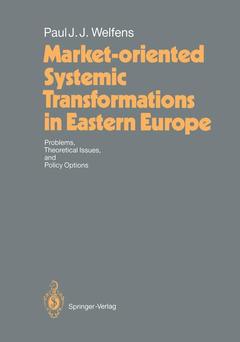Market-oriented Systemic Transformations in Eastern Europe, 1992 Problems, Theoretical Issues, and Policy Options
Langue : Anglais
Auteur : Welfens Paul J.J.

Socialist economies in Eastern Europe have collapsed and em- barked upon market-oriented reforms. The causes of the demise of centrally planned economies are analyzed and the basic challenges of systemic tranformation discussed. Negative income and wealth effects as well as distribution issues make adjustment extremely difficult. The fundamental roles of privatization and foreign investment are adressed. Foreign economic liberalization is considered to be of centralimportance for a growth-oriented adjustment path in a stage of conflict-prone policy and options. Politico-economic aspects of the new European developments in addition to North-South issues are analyzed. Difficult choices await decison-makers in economic policy and the business community in Eastern Europe and in leading market economies.
A: Characteristics of the Centrally Planned Economy and Systemic Collapse.- 1. The Rise and Fall of Marxist Theory and Socialism.- 1.1 The Crisis of the Socialist Systems in Eastern Europe.- 1.2 Some Stylized Facts.- 2. Distortions of Socialist Economics.- 2.1 The Monopoly Problem.- 2.2 Innovation Gap, Inefficient Investment and Stagnation.- 2.3 State-administered Allocation of Goods and the Pricing Rules.- 2.4 Tendency to Build up Reserve Capacities.- 2.5 Quasi-inflation in the Socialist Economy.- 2.5.1 Administered Prices and Preferential Supply in the Official Economy.- 2.5.2 The Dynamics of the Socialist Shadow Economy.- 2.5.3 Differentiated Product Supply in a Command Economy.- 3. Stagnation and Collapse.- 4. Dramatic Changes in Eastern Europe.- Appendix Al: Quality Gaps in Socialism Modelled in a SALOP-SALANT Approach.- B: Inefficiency, Instability, and Restricted Options.- 1. Introduction.- 2. The Scope of Transformation and the Sequencing Issue.- 2.1 Dimensions of the Transformation Problem.- 2.2 Distortions and the Need for Efficiency and Stabilization.- 2.3 The Inefficiency Problem.- 2.3.1 The Starting Point — Inefficiency and Adjustment Costs.- 2.3.2 Neutralizing Distortions as a Second-Best Strategy.- 2.4 Monetary Stabilization: Need, Process and Effects.- 3. Restricted Options in Transforming Socialist Economics.- 3.1 Fiscal Policy and Monetary Stabilization.- 3.2 Side-Constraints: The Income Distribution Issue.- 3.3 Joint Systemic Transformation and Regional Cooperation?.- 3.4 Some Lessons from the Asian NICs and Latin America.- C: Privatization and Foreign Investment in Eastern Europe.- 1. In Search of Private Owners and Entrepreneurship.- 1.1 The Economic Challenge of Privatization.- 1.2 Early Developments in Privatization and Foreign Investment in Eastern Europe.- 2. Privatization and Resistance to Systemic Change.- 2.1 Basic Issues of Privatization.- 2.2 Macroeconomic, Organizational and Strategic Problems.- 2.2.1 Political Rationale versus Economic Rationale.- 2.2.2 Devaluation, Wealth and Welfare.- 2.2.3 Restitution without Privatizing Foreign Debt?.- 2.2.4 Compensation vs. Restitution.- 2.2.5 Ownership Structure Problems.- 2.2.6 Strategics for Privatization.- 2.3 Rent-Seeking and Wage Bargaining: The Role of Privatization.- 2.4 Asset Prices and Sequencing.- 3. Economic Challenges of Foreign Direct Investment in Eastern Europe.- 3.1 Some Links between Privatization and FDI.- 3.2 Role of FDI in Economic Development: Some New Aspects.- 3.3 Information Costs and Common Investment Policies.- 3.4 How Significant Can Foreign Direct Investment Be?.- 3.5 Regional Diversification.- 3.6 “C1ub Goods” in Host Countries.- 4. Normative Conclusions for Policy Concepts.- Appendix C1: Competition and Prices in Systemic Transition.- D: Foreign Economic Liberalization in Eastern Europe.- 1. The Challenge of Foreign Economic Liberalization.- 1.1 Convertibility.- 1.2 Expected Macroeconomic Effects of Foreign Economic Liberalization.- 2. Strategic Role of Foreign Economic Liberalization.- 2.1 Import Competition.- 2.2 Export Liberalization.- 2.3 Sequencing and Foreign Direct Investment.- 2.3.1 Demonopolization.- 2.3.2 Strategic Role of FDI.- 2.4 Links between Trade Liberalization and Foreign Direct Investment.- 3. Liberalization and Economic Integration.- 3.1 The Role of the EC.- 3.2 West European Integration and Eastern Europe.- 4. Role of a New Marshall Plan.- Appendix D1: Ratio of Consumer Surplus to Producer Surplus.- Appendix D2: A New Supply-augmented IS-LM Model.- Appendix D3: Exports to European A Partners as a Percentage of Total Exports.- E: East-West Problems in Europe and North-South Conflicts.- 1. The New Europe.- 2. Economic Aspects of Instability and Conflict in Europe.- 2.1 Is Europe Returning to the Interwar Period?.- 2.2 Replacing Coercion with Positive Economic Interdependence.- 2.3 Politico-economic Aspects of the East European Transformation.- 2.4 The Role of the New Germany.- 3. North-South Conflicts and Global Aspects.- 3.1 “De-socialization” of Developing Countries: Changing North-South Conflicts.- 3.2 New Global Security Structures.- 3.3 Proliferation Problems and the Need for a New Schuman Plan.
Date de parution : 10-2012
Ouvrage de 264 p.
17x24.4 cm
Disponible chez l'éditeur (délai d'approvisionnement : 15 jours).
Prix indicatif 105,49 €
Ajouter au panierThèmes de Market-oriented Systemic Transformations in Eastern Europe :
© 2024 LAVOISIER S.A.S.



